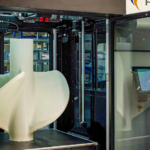3D Printing: The Future of Customized Manufacturing
3D Printing has revolutionized the way products are designed and manufactured, offering unparalleled customization and efficiency. This advanced technology enables the creation of intricate, high-quality components across various industries, from aerospace to healthcare.
3D printing, also known as additive manufacturing, is a process that creates three-dimensional objects layer by layer using digital models. Unlike traditional manufacturing, which often involves subtracting material, 3D printing builds objects from the ground up, minimizing waste and maximizing precision.
How 3D Printing Works
- Design & Modeling – A 3D model is created using CAD (Computer-Aided Design) software.
- Slicing & Processing – The model is converted into layers using slicing software, which generates instructions for the 3D printer.
- Printing & Fabrication – The 3D printer builds the object layer by layer using materials such as plastics, metals, resins, and composites.
- Post-Processing – Depending on the application, the printed part may undergo additional finishing processes like polishing or painting.
**Benefits of **3D Printing
- Customization: Easily modify designs to meet specific requirements.
- Reduced Waste: Uses only the necessary amount of material, making it environmentally friendly.
- Faster Production: Speeds up prototyping and production timelines.
- Cost-Effective: Reduces the need for expensive molds and tooling.
**Applications of **3D Printing
- Aerospace: Lightweight, high-strength components for aircraft and spacecraft.
- Medical: Customized prosthetics, implants, and surgical tools.
- Automotive: Rapid prototyping and production of custom car parts.
- Consumer Goods: Personalized products like jewelry, footwear, and home decor.
**Future of **3D Printing
As technology advances, 3D printing is expected to become more accessible and efficient. Innovations in materials, speed, and scalability will further enhance its role in manufacturing, making it an indispensable tool for industries worldwide.
Conclusion
3D printing is reshaping modern manufacturing with its precision, versatility, and efficiency. As industries continue to adopt this technology, the possibilities for innovation and customization are limitless.

